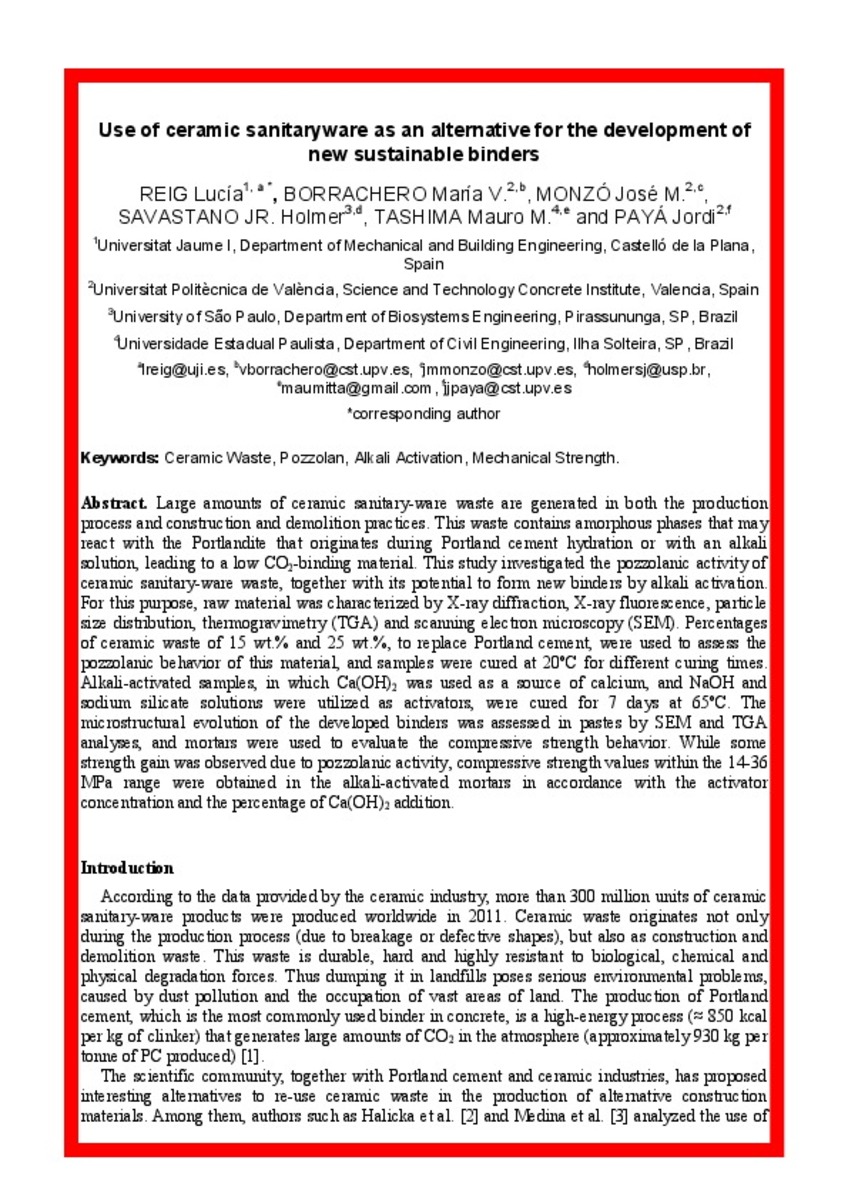Mostrar el registro sencillo del ítem
Use of ceramic sanitaryware as an alternative for the development of new sustainable binders
| dc.contributor.author | Reig, Lucía | |
| dc.contributor.author | Borrachero, Mª Victoria | |
| dc.contributor.author | Monzó, J. | |
| dc.contributor.author | Savastano, Holmer | |
| dc.contributor.author | Tashima, M. M. | |
| dc.contributor.author | PAYÁ, JORDI | |
| dc.date.accessioned | 2016-05-06T07:45:13Z | |
| dc.date.available | 2016-05-06T07:45:13Z | |
| dc.date.issued | 2016 | |
| dc.identifier.citation | REIG, Lucía, et al. Use of ceramic sanitaryware as an alternative for the development of new sustainable binders. Key Engineering Materials, 2016, vol. 668, pp. 172-180 | ca_CA |
| dc.identifier.issn | 1013-9826 | |
| dc.identifier.issn | 1662-9795 | |
| dc.identifier.uri | http://hdl.handle.net/10234/159333 | |
| dc.description.abstract | Large amounts of ceramic sanitary-ware waste are generated in both the production process and construction and demolition practices. This waste contains amorphous phases that may react with the Portlandite that originates during Portland cement hydration or with an alkali solution, leading to a low CO2-binding material. This study investigated the pozzolanic activity of ceramic sanitary-ware waste, together with its potential to form new binders by alkali activation. For this purpose, raw material was characterized by X-ray diffraction, X-ray fluorescence, particle size distribution, thermogravimetry (TGA) and scanning electron microscopy (SEM). Percentages of ceramic waste of 15 wt.% and 25 wt.%, to replace Portland cement, were used to assess the pozzolanic behavior of this material, and samples were cured at 20oC for different curing times. Alkali-activated samples, in which Ca (OH)2 was used as a source of calcium, and NaOH and sodium silicate solutions were utilized as activators, were cured for 7 days at 65oC. The microstructural evolution of the developed binders was assessed in pastes by SEM and TGA analyses, and mortars were used to evaluate the compressive strength behavior. While some strength gain was observed due to pozzolanic activity, compressive strength values within the 14-36 MPa range were obtained in the alkali-activated mortars in accordance with the activator concentration and the percentage of Ca (OH)2 addition. | ca_CA |
| dc.description.sponsorShip | The authors are grateful to the Spanish Ministry of Economy and Competitiveness for supporting this study through Project GEOCEDEM BIA 2011-26947 and FEDER funding. | ca_CA |
| dc.format.extent | 9 p. | ca_CA |
| dc.format.mimetype | application/pdf | ca_CA |
| dc.language.iso | eng | ca_CA |
| dc.publisher | Trans Tech Publications | ca_CA |
| dc.relation.isPartOf | Key Engineering Materials, 2016, vol. 668 | ca_CA |
| dc.rights | © Trans Tech Publications | ca_CA |
| dc.rights.uri | http://rightsstatements.org/vocab/InC/1.0/ | * |
| dc.subject | alkali activation | ca_CA |
| dc.subject | ceramic waste | ca_CA |
| dc.subject | mechanical strength | ca_CA |
| dc.subject | pozzolan | ca_CA |
| dc.title | Use of ceramic sanitaryware as an alternative for the development of new sustainable binders | ca_CA |
| dc.type | info:eu-repo/semantics/article | ca_CA |
| dc.identifier.doi | http://dx.doi.org/10.4028/www.scientific.net/KEM.668.172 | |
| dc.rights.accessRights | info:eu-repo/semantics/openAccess | ca_CA |
| dc.relation.publisherVersion | http://www.scientific.net/KEM.668.172 | ca_CA |
Ficheros en el ítem
Este ítem aparece en la(s) siguiente(s) colección(ones)
-
EMC_Articles [806]







